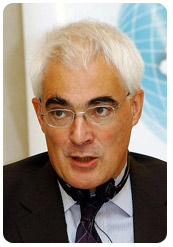What’s going on, Darling?
- 10 December 2009
 |
|
Alistair Darling |
With just under six months until a general election must held, the government wanted this week’s Pre-Budget Report to set out coherent plans for ‘saving’ the public services while recovering the public finances.
Instead, chaos erupted over the future of the National Programme for IT in the NHS, which the Chancellor said would be scrapped one day, only for the health secretary to contradict him another. Sarah Bruce reports.
At the end of Alastair Darling’s Pre-Budget Report to the Commons, it seemed as if the theme for the NHS was a slight shift in emphasis from making efficiency savings to implementing a pay freeze on staff facing increases in taxation.
At the end of a closer reading of the Treasury documents, it became clear that the theme was really keep on making those efficiency savings while implementing a pay freeze and finding £446m in national insurance contributions.
Protecting NHS funding, sort of
The Chancellor pledged to protect ‘frontline’ health services, saying: “spending on crucial front-line services will continue to rise, over and above inflation, after 2010-11.”
But while health has got off quite lightly in comparison to other departments, the coming years will be a struggle after a decade of rises of around 7% a year.
Professor John Appleby, chief economist at The King’s Fund, pointed out that increasing 95% of NHS funding ‘in line with inflation’ would mean a real terms budget cut, given that health service inflation is so much higher than that in the general economy.
He also raised questions about the ‘missing’ 5% of funding apparently exempted from the Chancellor’s promise, and what would happen after 2012-13.
“Clarity is needed about what is at risk if the ‘unprotected’ 5% is cut – equivalent to around £5 billion for the NHS in England,” he said. “There may be savings to be made in administration costs, but if training or research are cut that could have consequences for future productivity and quality.”
The Treasury will certainly be looking for ‘efficiency’ savings. This spring, NHS chief executive David Nicholson warned the NHS might have to find £15-£20 billion by 2014, to bridge the gap between a standstill in funding and the demand caused by an aging population and other pressures.
In the Pre-Budget Report, this has become a “challenge” to the NHS that will be formalised in a programme of savings in the Budget 2010.
In the meantime, savings of up to £10 billion a year are expected by 2011-12, mostly from ‘adjusting’ the tariff paid for acute work, applying a tariff to community and mental health services and finding back office and procurement savings.
Scrapping NPfIT, or not
Professor Appleby notes that it is rarely easy to save money in the NHS. “There will have to be trade-offs if we want a health care system which is fit for the 21st Century,” he says.
A healthcare system that is fit for the 21st Century must surely be one that makes much more use of IT and technology than the NHS does now. Yet earlier in the week, there was turmoil – if not utter confusion – between the Treasury and the Department of Health over the future of the National Programme for IT in the NHS.
On Sunday, on The Andrew Marr Show, Darling suggested it might be scrapped completely. “The NHS has quite an expensive IT system that, frankly, is not essential for the front line. That’s something we do not need to go ahead with just now,” he said.
The statement shocked everyone in NHS IT, particularly the local service providers, CSC and BT, and the ‘strategic’ software providers Cerner and iSoft, who, according to sources, had not been forewarned.
Burnham eased concerns in an emergency statement in the Commons on Monday, in which he launched a spirited defence of the programme, while confirming that he and officials had been looking for savings at the behest of the Treasury.
He said £600m would be shaved off the £12.7 billion project, but did not clarify what elements of the programme would be scaled back.
Melissa Frewin, head of healthcare at Intellect, regretted this. "There’s a lot of confusion in the market and what suppliers really need is a clear signal from government on the future direction of health IT," she said.
"Of course the government needs to make sure it’s spending as prudently as possible in the current economic climate, but it must also realise there are real efficiency savings to be made through intelligent use of IT across the health service.”
Briefings to journalists later suggested that NHS Connecting for Health would be expected to make some of those back office savings, and that some of the programme’s later and fancier functionality would be scrapped.
ISoft executive chairman and chief executive Gary Cohen downplayed the excitement. “The deliverables we have got scheduled for the next 12 months are on track and will go ahead,” he said. “While I expect there will be some reshaping of contractual arrangements to apply them to more relevant areas, that will potentially have more relevant benefits to us.”
Coping mechanisms
The confusion over the national programme may reflect a deeper confusion in government over how to get public services to respond to the financial crisis caused by the failure of the banks.
The Treasury’s apparent response – cut the tariff, reconfigure services, look for back office savings – is the traditional response that the Department of Health has been telling managers it does not want to see in the NHS this time.
Instead, it has been focusing on the need to improve quality, innovation, productivity and prevention (the so-called QIPP agenda), which implies a need for more IT at least in some areas, such as telehealth.
Tola Sargeant, researcher director at TechMarketView, said the Pre-Budget Report identified £250m savings on residential care. “That must mean greater use of preventative approaches to keep older people in their homes for longer. In other words, technologies like telecare and telehealth look set to benefit.”
Meanwhile, Prime Minister Gordon Brown has been promoting the Cabinet Office’s ‘third generation public services’ agenda, which calls for ‘smarter’ government services delivered through more transactional websites and more information for the public to drive choice.
With an election just six months away, it is far from clear which of these approaches will come out on top. The Treasury’s official Pre-Budget Report failed even to clarify the amount of money that will be cut from the national programme.
In the report, it is mentioned in a £5 billion package of government-wide savings to be achieved by 2012-13, but the Treasury appears to think that: “£500m [will come from] reducing spend on IT, including reducing the cost and scope of the NHS IT programme."
As Sergeant noted: “Rather confusingly, that is less than the £600m Andy Burnham promised to save from NPfIT alone on Monday.”
A long election campaign
The Tories have been keen to highlight government “disarray.” Stephen O’Brien, shadow health minister, told E-Health Insider: “The Chancellor claims that NHS IT is not “essential for the frontline” but the next day Andy Burnham assures the House that the programme makes the NHS ‘safer’ and ‘more efficient’.
“The government is clearly in disarray on this issue, whereas the Conservatives have laid out a detailed policy and implementation strategy: local choice for trusts to enable tailor-made IT systems; open standards to guarantee interoperability, innovation and competition; and a localised, grass-roots vision of IT that supports a more efficient and patient-centred NHS for the benefit of both patients and taxpayers.”
In his speech, Darling made it clear that Labour will not run another comprehensive spending review to replace the one that runs out at the end of the financial year; but will be interrupted by the general election that must take place by 3 June.
“This inevitably means a period of uncertainty and inaction in the UK public sector that is likely to last well into 2010,” Sergeant concluded.




